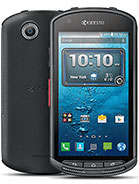Walker County and Kyocera's DuraForce PRO 2 (AT&T FirstNet) By Kyocera Mobile
We're going out in almost the worst environment you can imagine you know your typical jobs, Monday through Friday, an office with air-conditioned and lighting. Our typical day in the office is on the side of the road in the weather, in the heat in the rain and the dirt, just the worst environments imaginable, and we need a device. That's going to hold up through all that our PS covers nine counties within the state, and we have a good mix of some urban areas and also a lot of really rural areas. Small towns and small communities that we serve mobile devices are very important in our line of work. We have to have equipment that works. We have to be able to allow NAT to work and when it doesn't, things really fall apart.
It's crucial because you know and our field we need to be able to communicate with each other, and immediately I'll, be at the 1600 block of Tommy Robinson Road, if we're not able to communicate with dispatch or other deputies when we're out on a violent suspect or a dangerous call that can put our life in danger in the past. Depending on where we're at in the county, you'd Kia, you wouldn't get service, the radio would just come across the screen that their transmitters were down. Sometimes it would be muffled, sometimes it would cut in and out or just not even come across at all, and then you're stuck so a little over a year and a half ago we got the word that the old Aden system for push-to-talk was going to be shut down, and after we got that news, we realized we had to find a digital push-to-talk system that would allow us to communicate effectively between dispatching the crews. At the time when we found that the first net program was now going to be open in Alabama, we gained a few test devices and sort of putting those out in the field and testing them in our areas. So the whole entire chrome Center has just rolled out to the new first net push-to-talk.
We use up on a day-to-day basis for every call from being dispatched to talking to the trauma. Centers I would say that we do a lot of mobiles to bus use. Every day when we found out that we were going to have to switch radio communication devices, we looked at several companies. We talked to them about what they had to offer, what their limitations were, and we decided to go with 80 and the Kyocera deer force Pro to kiss here has done a wonderful job of being a partner with us. As far as the deployments being concerned, they have people stationed out, they can do custom configurations and stuff of the devices for your organization.
If you need it, they also have people on their support team that, if you've got a problem, you can call them and get a response back. You know pretty much instantaneously. We just finished the trial phase with it, and we're now getting in the hands of the crews to see what they, how they feel about it, and the feedback so far has been overwhelmingly positive, that it's a night and day difference between that and the device that they were previously using. Not only does the Sheriff's Office use the Kyocera aura force, Pro ?, we have our emergency first responders that use them as well, which allows for some inner communication between the agencies and the fire response and emergency medical services. Now we're using the aura force, Pro ? and whenever our dispatchers key up their transmissions are clear, and we're able to get all the information that we need.
We use the aura force, Pro ? for radio communication on the enhanced push-to-talk app text messaging, taking photographs. We use third-party apps to track people with GPS. Furthermore, we use the Wi-Fi hotspot to connect our data terminals and all this is going on at the same time, while we're out in the field and the device works, seamlessly I put the Kyocera to the test, and it works great, and it's one of the most durable devices that I've had you.
Source : Kyocera Mobile

























